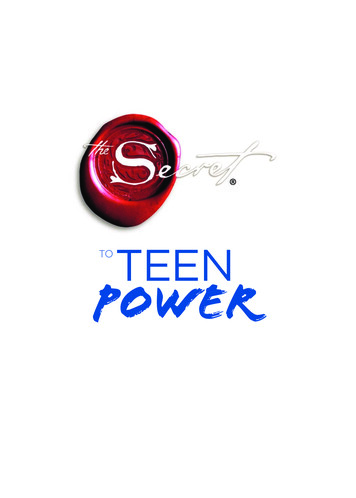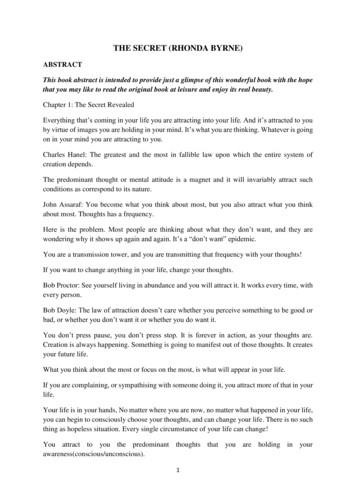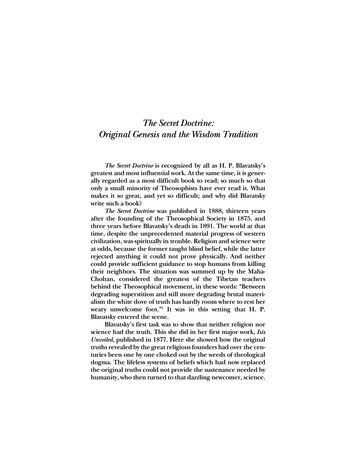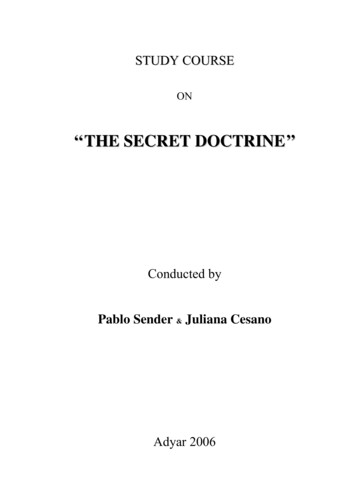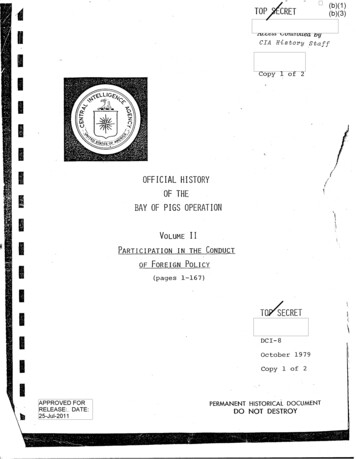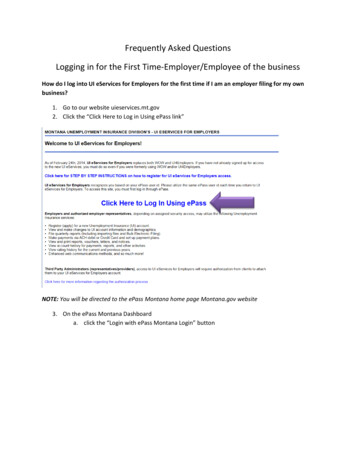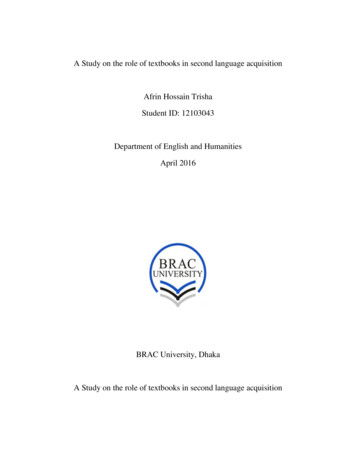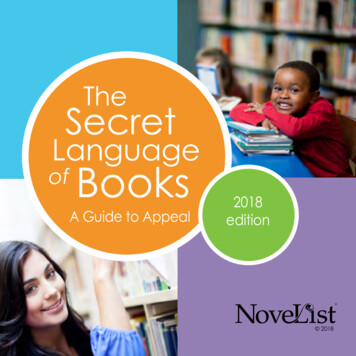
Transcription
TheSecretLanguageofBooksA Guide to Appeal2018edition 2018
WelcomeHave you ever wondered if bookshave their own secret language? We atNoveList think they do, and we call itappeal.We created this language in response toreaders, librarians, and reading trendsand, with your help, it’s grown andadapted to serve you better.Appeal is how a book whispers to areader. It’s how a memoir leaves themfeeling inspired or a novel leaves themwondering if the narrator was beingstraight with them, long after they’veclosed the pages.Our metadata librarians spend their daysdiscussing and evaluating appeal tomake your job of finding a reader’s nextamazing read, easier. We’re proud of thiswork and we’re proud of the role youplayed in making it happen.When books speak to us at NoveList andto readers in your library in appeal, theyaren’t speaking about subject matter(nurses, diaries, Presidents, Antarctica,etc.), they are speaking style and how thebook feels.We welcome your feedback to makeappeal even better! What term wouldhelp you find your next favorite book?Let us know at novelist@ebsco.com.Using the groundwork laid by JoyceSaricks, Nancy Pearl, Neal Wyatt,and others, NoveList introduced ourvocabulary describing book appeal in2010.Happy reading!Elizabeth Coleman, MLSMetadata Librarian II
Starter QuestionsUse these to start conversations with readers.Can you tell meabout a bookyou’ve read andenjoyed?Which of yourfavorite authorsor series do youwish had anew book?What moviesand TV showshave youenjoyed?What areyou in themood fortoday?
AGES 0-8AGES 9-12TEENSAUDIENCE(S) THISTERM APPLIES TO:ADULTSPacePace is the rate at which a story unfolds for thereader. We identify books at either end of thespectrum. We also tag those that start slowly,then accelerate as the story progresses.Fast-pacedEvents in these exciting books unfold rapidly, moving the readerquickly through the story.IntensifyingThese books gradually build in momentum throughout the story,resulting in a gripping conclusion.Leisurely pacedDue to descriptive language, focus on detail, or careful developmentof character or setting, these books unfold slowly, allowing thereader to savor the narrative.Why so few pace terms? According toNeal Wyatt, nobody’s really looking for“medium-paced” books – it’s only an activeappeal when it stands out on the spectrum.
Making ComparisonsUse comparisons to dig deeper into reading preferences. Do youprefer action-packed or character-driven stories? Fast or leisurelypaced? Heartwarming and homespun, or disturbing and creepy?
Pulse-pounding, high-octane excitement is the rule!Character-driven Fiction use onlyInterior growth and development of characters is important.Intricately plottedThese books have intricate, complicated, or elaborate storylines, ofteninvolving multiple plots or numerous narrative twists and turns.Issue-orientedIssue-oriented books explore controversial themes, which may coveremotional, ethical, or social problems.NonlinearInstead of being portrayed chronologically, events in these books shiftbetween time periods.Open-endedInstead of providing answers, these books invite readers to ponderevents long after the last page.Plot-driven Fiction use onlyEvents rather than characters propel these stories forward.SweepingThese sprawling stories span decades or generations and frequentlyinclude multiple locations and historical events.UnconventionalUsing unique or unexpected elements, these books may twist, adapt, orplay on conventional storylines.World-buildingThese books immerse the reader in vivid imaginary worlds of inventedhistories, languages, geography, or cultures.AGES 0-8TEENSAGES 9-12Action-packedAUDIENCE(S) THISTERM APPLIES TO:ADULTSStorylineStoryline is a quick way to determine a book’sfocus and structure.
SWEETROMANCESTRYChasteHeartwarmingHomespunUsing Tone toNarrow a GenreHow much sex is too much?Whether romance readers arelooking for some good, clean fun,or a down and dirty romp,appeal can help find theirsafe word (or comfortzone).MILDROMANCESTRYMildy sensuousUpbeatHOTROMANCESTRYExplicitMoodySteamy
AmusingThey may not make you laugh out loud, but these stories have a lighthumor that sometimes accentuates more serious themes.Angst-filledCharacters in these books experience problems associated withadolescence, such as questions about sexuality, popularity, orsocial standing.AtmosphericThese books evoke the story’s setting, whether it’s a gothic mansion ora small Midwestern town.BittersweetA mixed emotional edge—both pleasant and painful—that issustained throughout the story.BleakA dark outlook, frequently devoid of faith in human nature andtending away from hope or optimism.ChasteThese books about romantic relationships focus on the emotions ofthe characters, and contain no sex or descriptions of sexual activity.Conservative Nonfiction use onlyRepresents a conservative (often Republican) perspective onAmerican politics and social issues such as the environment, poverty,and the economy.AGES 0-8AGES 9-12TEENSAUDIENCE(S) THISTERM APPLIES TO:ADULTSToneTone is the feeling that a book evokes in thereader. In many cases, this category best answersthe question, “What are you in the mood for?”
Unsettling in a visceral, skin-crawling way, these books make the readeruneasy, and may often have supernatural elements and eerie settings.Darkly humorousThe humor in these books derives from ironic or grimly satiric treatment ofdeath, suffering, and other morbid subjects.DisturbingApproaching the darker side of human nature, these books are unsettlingand often portray socially marginal or dysfunctional individuals.DramaticThese cinematic books feature exciting and larger-than-life stories,depicting anything from historical events to space warfare.Emotionally intenseConveying great depth or complexity of emotion, these books explore theinner lives of characters in detail.ExplicitThese books contain lots of vividly described sex, ranging from the plainest(but plentiful) vanilla to the kinkiest of kink.Feel-goodA gentle, comfortable, and hopeful feeling (not just a happy ending).FunnyLaugh-out-loud humor characterizes these books.GossipyActions and people tend to be over-the-top and salacious.GrossYuck! Including lots of nasty, oozy, or disgusting facts or details, thesebooks may be educational or purely for entertainment.AGES 0-8AGES 9-12TEENSADULTSToneCreepy
ToneGruesomeNot for the squeamish, these books include a significant amount of explicitgore or other grisly elements.HauntingOften because of hard-hitting storylines, these books have a memorable,unforgettable quality that stays with the reader.HeartwarmingThese uplifting stories ultimately leave readers feeling emotionallysatisfied.HeartwrenchingThese books convey emotions that are keenly distressing, hitting a nervewith readers and deeply affecting them.High-dramaJuicy, sensational, and melodramatic, these books deal with back-stabbingsocial scenes and catty personalities.HomespunSimplicity is key, often with a rural or small-town setting and charactersthat are unpretentious and cherish old-fashioned values.HopefulWhile addressing weighty issues, these books incorporate some optimisticelements, expressing the belief that things may improve.Humor comes in many varieties, so you’ll wantto get specific Are you looking for lighthumor? Try amusing, funny, irreverent, or silly.Want something more edgy? Look for darklyhumorous or sardonic.
Presents a balanced view of a contentious subject.Impassioned Nonfiction use onlyThese books convey strong emotions to readers because the authors areforcefully advocating a particular point of view, making an argument, ortelling an emotional story.InspiringThese books have an inspirational, enlightening, or uplifting quality, whichmay or may not be religious in nature.IrreverentNo institutions, people, or beliefs are off-limits in these humorous (andsometimes subversive) books.Liberal Nonfiction use onlyRepresents a liberal (often Democratic) perspective on American politics,politicians, and social issues such as the environment, poverty, and theeconomy.MelancholyWhile not grim or hopeless, these books are sad, somber, or gloomy.MenacingA sense of threat or menace pervades, evoking feelings of dread.Mildly sensuousSex is present, but it’s not given pride of place. Relationships are mostimportant, but sometimes characters act on their attractions.MoodyA dark and brooding tone that borders on melodrama.MovingEmotionally resonant books that make readers feel invested in both thecharacters and the story.AGES 0-8AGES 9-12TEENSADULTSToneImpartial Nonfiction use only
ToneMysticalTouching on spiritual themes, these books often explore archetypes andincorporate metaphysical events.NoisyBecause of rousing, energetic pictures or text, these stories lendthemselves to loud readings.NostalgicCharacters reminisce, or the book looks back toward a particular place ortime with longing and wistfulness.OffbeatThrough plot twists, bizarre humor, and unique personalities, these quirkybooks recount unconventional, idiosyncratic, or unusual stories.PatrioticThese books celebrate and show pride in one’s country and its achievements.QuietSoothing, low-key stories that have a calming effect on young readers.Racy humorIncluding coarse or risqué material; these books refer to sex in a humorousway.ReflectiveContemplative books featuring characters who think seriously about theirlives and place in the world.Some tone words are just for kids – for example,gross, noisy, quiet, silly, scary, & sweet are allterms that can help you find the perfect book forstorytime, read-alouds, or (best of all!) naptime.
Not genre romances, but featuring strong romantic elements—eitherbetween characters or in the story itself. Happy endings not guaranteed!SadIssues in these books may be very serious (such as death), or less seriousbut still challenging (such as a friend moving away).SardonicDry humor and biting wit set the tone in these stories.ScaryThese spooky books have a frightening or menacing feeling that will makeyoung readers uneasy.Self-deprecating Nonfiction use onlyNever taking themselves too seriously, the authors humorously expose theirown embarrassments, making readers sympathize, laugh, and sometimescringe!SeriousMarked by seriousness, gravity, or solemnity, these books confront socialissues such as war, poverty, gender, or racial concerns.SillyThe class clowns of literature, these books are often quite absurd andridiculous but lots of fun.SoberingAddressing weighty social issues, these serious and hard-hitting bookspresent a perspective that may be revelatory to the reader.Spiritual Nonfiction use onlyThese nonfiction books represent a spiritual outlook on religion andspirituality.AGES 0-8AGES 9-12TEENSADULTSToneRomantic
ToneSteamyIn adult books, the sex is pretty vivid and goes beyond just innuendo. Inteen books, there is still an unmistakably sexy aura, although perhaps notas much graphic detail.Strong sense of placePowerfully depicted locales—real or imaginary—come alive and give agood sense of what makes a place unique.SuspensefulRanging in intensity from subtle psychological unease to nail-bitingsuspense, these books keep readers on edge.SweetWith a light tone and appealing innocence, these endearing books arecute, playful, and otherwise delightful.Thought-provokingMore than just telling a story, these books take on big ideas—anythingfrom philosophical quandaries to time paradoxes.UpbeatThese fun books are lighthearted, hopeful, and optimistic.ViolentNot for the faint of heart, these books contain explicit or graphic violence.WhimsicalThese fanciful and playful books will charm and enchant readers, and ofteninclude fairy tales or other elements of fantasy.For readers with a passion for place, direct themto books with a strong sense of place, and thenpair it with a subject heading for a location—anything from Paris to Middle Earth.
Characters readers love(and the appeal that tells you why)Readers fall in lovewith Nimona, thequirky, spirited,strong femalevillian, even as she’splanning attacks oncities with geneticallymodified dragons.Trapped on Mars,courageous MarkWatney keepsreaders on the edgeof our seats, but it’shis snarky sense ofhumor that makeshim relatable.Competitionbetween brothersas told by Josh, abelievable characterappealing to middlegrade kids intosports and culturallydiverse characters.
Ability diverseThese characters live with physical, mental, or emotional conditions thatcan often be challenging.AnthropomorphicFrom cats solving mysteries to crayons quitting their day jobs, the nonhuman characters in these books offer a unique perspective.AuthenticThese characters behave in ways that accord with their age, nationality,and backgrounds.AwkwardOften unsure of themselves, these characters lack the social savvy tonavigate relationships and other interpersonal situations smoothly.BelievableThese characters ring true for young readers, and behave in ways that areconsistent with their age and backgrounds.BroodingHaunted by past traumas or mistakes, these morose characterscontemplate (and often must confront) what is wrong in the world.Character duosFrom best friends to odd couples, these books feature dynamic duos whotake on the world together!AGES 0-8AGES 9-12TEENSAUDIENCE(S) THISTERM APPLIES TO:ADULTSCharacterOnly applied to fiction books, character appealis especially for those readers who love booksbecause of the characters.
Intriguing and complicated, these multi-dimensional characters haveconflicting motivations and desires.CourageousThese brave and often self-sacrificing characters have strong convictionsand face challenges with determination, despite the odds against them.Culturally diverseThese books may feature characters from racial and ethnic minorities livingin the United States, Europe, Canada, or Australia, as well as charactersfrom non-white cultural groups living in other parts of the world.ExaggeratedThese larger-than-life characters often delight readers by adding to thehumor or uniqueness of a story.FlawedThese characters do not always act in their own best interests, and theirsometimes misguided decisions form a central theme in the story.IntrospectiveThese characters examine their own feelings, thoughts, and motives, andwhat they find often has major repercussions for the story.Large cast of charactersWhether because of sprawling storylines, epic scopes, or intricate plots,these books contain lots of characters—how well readers get to knowthem depends on the author.AGES 0-8AGES 9-12TEENSADULTSCharacterComplex
CharacterLGBTQIA diverseIdentifying as lesbian, gay, bisexual, transgender, queer, intersex, asexual,or just questioning, these characters are not stereotypes and are importantto the story (even if in a secondary role).LikeableThese appealing characters engage readers and are likeable, despite flaws.MischievousThese child characters frequently get into trouble or cause minor disastersdue to their curiosity or intentional disregard for the rules.QuirkyEccentric and idiosyncratic, these characters range from peculiar to bizarre,and generally add to the charm or humor of the stories in which theyappear.RelatableBecause their emotions and experiences are recognizable, readers are ableto identify with these characters and their dilemmas.Religiously diverseThese characters follow or have a background in a religion other thanChristianity. While their active level of involvement in the religion mayvary, the character’s religious beliefs are an important element in the story.Responding to the recent call for more diversity(#WeNeedDiverseBooks) in children’s literature, wecall out different kinds of diversity in our characterappeal terms. Look for ability diverse, culturallydiverse, LGBTQIA diverse, and religiouslydiverse characters.
These young characters sometimes employ sarcasm for humor, andsometimes in response to difficult or challenging situations.SassyThese books feature characters (usually women) with outsizedpersonalities and a bottomless well of one-liners and comebacks.SnarkyThese characters employ sarcasm, irony, and biting wit in theirapproach to life (and often have fun with it!).SpiritedThese lively characters are full of energy and vigor.SpunkyFeisty and scrappy, these characters have pluck and determination.Strong femaleWhether catching criminals or saving the world, these take-chargewomen and girls are at the top of their game.SympatheticWhile sometimes dealing with difficult situations or making poordecisions, these characters are presented in such a way that readersempathize with them.TwistedDeviant and often unsettling, these characters push the boundaries ofliterature through behavior that ranges from disturbing to illegal.AGES 0-8AGES 9-12TEENSADULTSCharacterSarcastic
CharacterUnlikeableDeliberately painted in an unflattering light, these characters will notgain the sympathy of readers, so there is less emotional investment ifand when bad things happen to them.Well-developedSometimes appearing in more plot-driven stories, these characters riseabove others in the strength of their development.Have a reader who doesn’t mindspending time with uncomfortablecharacters?Try books with unlikeable ortwisted characters.
Different Writing StylesAppeal helps compare very different styles .WELL-CRAFTED DIALOGUEWITTYI am born not long from the timeor far from the placewheremy great-great-grandparentsworked the deep rich landunfreedawn till duskunpaiddrunk cool water from scooped out gourdslooked up and followedthe sky’s mirrored constellationto freedom.-- from Brown Girl Dreaming by JacquelineWoodsonWhere was Incandesto when youneeded him?Not that Flora really believed insuperheroes. But still.She stood at the window and watchedas the squirrel was vacuumed up.Poof. Fwump.“Holy bagumba,” said Flora.--from Flora & Ulysses by Kate DiCamilloLYRICALTHOUGHTFUL
These books explain a complicated or technical issue in an approachablemanner.Attention-grabbingIrresistible to young readers, these books instantly draw them in.Banter-filledThese books are characterized by snappy repartee.Browsable Nonfiction use onlyInformation is arranged in short sections and is often accompanied byillustrations or other graphics to encourage browsing.CandidThe narrative style of these books is frank and forthcoming, even whendiscussing potentially sensitive or uncomfortable subjects.CompellingThese powerful books draw readers irresistibly into the story.Comprehensive Nonfiction use onlyThese wide-ranging books thoroughly cover the background (andsometimes personalities!) of the subjects they explore.Concise Nonfiction use onlyWithout wasting a word, these nonfiction books deliver a wealth ofinformation in a succinct format.ConversationalWritten informally, these read as if a close friend were telling a story.DescriptiveFull of elaborate descriptions, with illustrative, expressive language.AGES 0-8TEENSAGES 9-12Accessible Nonfiction use onlyAUDIENCE(S) THISTERM APPLIES TO:ADULTSWriting StyleWriting style terms tell us how a book is written,from the complexity of the language to the levelof detail in the background.
Regional language and slang bring the setting to life.Easy-to-understand Nonfiction use onlyThese make hard-to-understand things a little easier.EngagingThese books capture the imagination of readers through narrative style,character, or use of detail.GrittyCharacterized by a narrative style that includes dark and unsettling details,these books often depict violence.Jargon-filledThese books use the specialized, technical language of a particular group,trade, or profession.Journalistic Nonfiction use onlyWritten about newsworthy issues, these books are well-researched butconversational, rather than scholarly.LushDescriptive language evokes the senses, making readers feel as if they areexperiencing what is being described.LyricalElegant, beautiful language, often with a rhythmic or poetic quality.Minimal textGenerally used with young children, these have few words per page. Thewords tend to be simple, and sentences are short.ParticipatoryThese books will require the reader to engage with the story by answeringquestions or through physical interaction.AGES 0-8AGES 9-12TEENSADULTSWriting StyleDialect-filled
Writing StylePersuasive Nonfiction use onlyThese books may present both sides of an issue, but are frequently used tobolster a specific opinion.Richly detailedDetails enrich these stories, sometimes focusing on a special body ofknowledge (e.g., forensics, music, history, etc.).Scholarly Nonfiction use onlyThoroughly researched and addressing complicated issues, the language inthese books is academic or technical.Slang-heavyCharacters in these books make frequent use of slang, which often aids incharacter development.SpareMinimal and elegant with great attention paid to the use of language.Stream of consciousnessThese novels and stories portray the uninterrupted and uneven flow of thecharacters’ consciousness.Stylistically complexDue to sophisticated language and narrative structure, these stories canoften be read on a number of levels.ThoughtfulDespite covering a sensitive or controversial topic, these books areconsiderately written and handle the subject with respect.Well-crafted dialogueThese books contain authentic or notable dialogue.WittyThese cleverly written books use language in an inventive, humorous way.Wordplay-filledThese books are full of puns, palindromes, anagrams, and other clever usesof language.
Different kinds ofIllustrationsNeed a storytime book? Big and bold illustrations can be seenfrom across a crowd. Detailed books give young readers achance to pore over the pictures. Colorful books are eyecatching for appealing displays!Big andBoldDetailedColorful
Big and boldThese illustrations convey ideas visually in a simple manner easilyunderstood by young children. The contrast between bright colors andbold lines makes the pictures easily visible from a distance, even within alarge group (and thus these books are a great choice for storytime!)Black-and-whiteThe artwork is in black and white only, and may range from pen and inkdrawings to watercolor-like effects in shades of gray.BoldThe shapes or lines in these illustrations have a strong and strikingappearance. The artwork may consist of simple, basic, or block-likeshapes, and the lines may be dark, distinct, or thick.CartoonyThis style features characters drawn with exaggerated, simplified features.Often humorous, it can be used to lighten difficult or disturbing themes.CharmingThese illustrations are captivating and pleasing to the eye. Often cute andplayful, they offer visual support for the light or upbeat tone in a story.ColorfulThe full-color illustrations in these books feature vibrant colors. Theartwork may vary widely, but the color palette is vivid.AGES 0-8AGES 9-12TEENSAUDIENCE(S) THISTERM APPLIES TO:ADULTSIllustrationBoth picture books and graphic novels have aunique set of qualities important to their readers,from color and drawing style to the mood evokedby the illustrations.
Often used for emphasis in stories with a bleak, menacing, or serious tone,these illustrations are full of shadows and dark corners.DelicateDeft and fine in texture or structure. Lines are thinly drawn, and the effectof these pictures is subtle.DetailedThese books convey a lot of information through the quantity and clarityof the detail within the objects and offer readers the chance to pore overthe pictures.FancifulThese illustrations are imaginative and unexpected and may range fromwhimsical drawings to surrealistic art with a dreamlike quality.Folk-art styleRecognized by its flat perspective, simplified or stylized shapes, anddramatic use of color; frequently appears to be created by either anuntrained artist or one who does not adhere to academic standards for art.ImpressionisticThese evocative illustrations use soft lines, reflected light, and color tocapture a sensory, emotion-filled impression of a scene or an object.InventiveThese creative books challenge the reader’s perceptions with non-standarduse of illustrative elements (including line, panels, or color).LavishWhether through use of color, line, or detail, these illustrations areelaborate, sumptuous, and striking.AGES 0-8AGES 9-12TEENSADULTSIllustrationDark
IllustrationMinimally coloredFeaturing a limited color palette, these books can be two-toned or grayscalewith one or two brighter colors used as accents.MutedThe subtle color may have a washed out or subdued quality. This restraintin the use of color often serves to set the tone of the story.NightmarishDeliberately ugly, frightening, or unpleasant. Most likely to accompanystorylines that are unpleasant with a creepy, disturbing, or menacing tone.PhotographicThese books use photographs as the primary method of illustration. Oftenfound in nonfiction books where photographs are the primary illustrations.RealisticThese illustrations use correct proportions and accurate perspective. Thecontent may not represent reality, but the drawing does.Rough-edgedThese illustrations are not sophisticated, polished, or elegant; instead,they have jagged lines and imperfect images, which serve to convey andemphasize the strong emotions being portrayed.SurrealThese illustrations have a dreamlike or unreal quality, and express theworkings of the subconscious. Typically done in a realistic style, they useunexpected juxtapositions of people or objects.TexturedThe visible texture of these illustrations adds realistic depth and detailthrough the skillful use of artistic medium.
Appeal toDifferent ListenersAll About the VoicesFind your newfavorite narrator!A Story and a ShowPrefer lots ofshowtime extras?Hooked on a FeelingLooking to evoke amood or feeling?SEARCH FOR:Character accentsEnergeticFolksyMultiple narratorsRead by the authorYouthfulSEARCH FOR:Audio dramaFull castLive audienceMusically enhancedSound effectsSEARCH FOR:ComedicDetachedEmotionally connectedEngrossingIntenseSomber
AGES 0-8AGES 9-12TEENSAUDIENCE(S) THISTERM APPLIES TO:ADULTSAudioAudio appeal covers everything from theperformance (full cast or read by the author) tovoice quality, tone, and artistic delivery.Audio dramaThese are either original audio productions, or were changed significantlyfrom a book to a more dramatic form of the work.ApproachableThrough their clear and well-paced performances, these narrators makechallenging concepts or language easier for listeners to understand.BriskThese narrators move their stories along with quick, agile readings.Character accentsIncorporating accents into their performances, these narrators bring bothcharacters and settings to life with their vocal versatility.ComedicThrough good use of comic timing, these narrators channel the humor ofthe stories they read and convey it to listeners.Notice that all the audio terms apply to allaudiences? Since they describe the narrator’sperformance, voice, or the overall production,these terms can apply to audiobooks at anyreading level.
These narrators deliver strong and authoritative performances.CrispThese narrators read in clear tones, with precise enunciation.DeadpanThe humor in these books—sometimes wry and sometimes riotous—isdelivered in a cool, impassive manner.DetachedThese performances are emotionally removed from the story, whichseparates the listener from the impact of violent or disturbing events.Distinctly voicedNarrators provide a multiplicity of voices for their characters, sometimesthrough accents, pitch, intonation, or tone. The result is that listeners caneasily identify who is speaking.Emotionally connectedBecause of their connection with the characters, these narrators capturethe emotional content of the books they read.EnergeticThese narrators imbue their performances with spirit, animation, andenthusiasm; adding to the humor, excitement, or drama.EngrossingThese narrators skillfully draw listeners into the story, providing amemorable listening experience.FolksyThese narrators highlight regional speech patterns, cadences, and dialects;often the characters they portray will be from rural areas, including but notlimited to the South.AGES 0-8AGES 9-12TEENSADULTSAudioCommanding
AudioFull castIn these performances, multiple narrators perform as individual charactersduring an interactive reading.GentleThese soothing voices are easy on the ear. Sometimes this narrative stylecan make difficult subject matter easier to process.GravellyThese narrators have husky, raspy, and throaty voices.ImmersiveNarration that captures the sensation of a time and place and immersesthe listener in the story’s setting.IntenseThrough dramatic, suspense-filled performances, these narrators keeplisteners on the edges of their seats.Live audienceNarrators or actors perform in the presence of a live audience.MelodiousLilting, dulcet voices offer a pleasing and almost hypnotic listeningexperience.What’s the difference between multiple narratorsand full cast? In a full cast audiobook, theperformers interact with each other while multiplenarrators typically read alternating chapters or anunique character’s part.
These performances include more than one narrator, often readingsections or chapters told from one character’s perspective.Musically enhancedIncluding anything from a few musical accents to a full musical score, thisis most often found in full cast performances or in juvenile audiobooks.Read by the authorIn these performances, authors double as narrators, and listeners get thechance to hear the text as voiced by the author.ResonantThese pleasing voices wash over the listener in rich and sonorous tones.Sincere Nonfiction use onlyWith their heartfelt performances, narrators of these nonfictionaudiobooks imbue their readings with genuine conviction.SomberThese performances underscore the serious nature of the stories.Sound effectsMost often fo
have their own secret language? We at NoveList think they do, and we call it appeal. Appeal is how a book whispers to a reader. It’s how a memoir leaves them feeling inspired or a novel leaves them wondering if the narrator was being straight with them, long after they’ve
